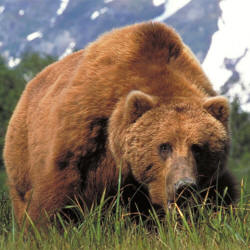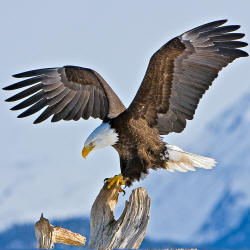World Animals
North American Animals
Grizzly Bear

Animal Kingdom: Brown bear, Mammal
Population: app. 31.000
Size: H: app. 1,5 m, L: app. 1,75 m
Weight: 160 kg - 225 kg
Life Expectancy: 15 years - 25 years
Food source: Fish and other birds
Max. speed: 56 km/h
Nutritional value: Loads of hormones and enzymes
The grizzly bear (Ursus arctos ssp.), is any North American subspecies
of the brown bear, such as the mainland grizzly (U. a. horribilis), the
Kodiak (U. a. middendorffi), the peninsular grizzly (U. a. gyas) and the
recently extinct California grizzly (U. a. californicus).[1] Specialists
sometimes call the grizzly the North American brown bear because the
grizzly and the brown bear are one species on two continents.[1] In some
places, some may nickname the grizzly the silvertip for the silvery,
grizzly sheen in its fur.
Except for cubs and females,[3] grizzlies are normally solitary, active
animals, but in coastal areas, grizzlies gather around streams, lakes,
rivers, and ponds during the salmon spawn. Every other year, females
(sows) produce one to four young (usually two)[4] which are small and
weigh only about 500 grams (1 lb). A sow is protective of her offspring
and will attack if she thinks she or her cubs are threatened.
In North America, grizzly bears previously ranged from Alaska to Mexico
and as far east as the western shores of Hudson Bay.[12] In North
America, the species is now found only in Alaska, south through much of
western Canada, and into portions of the northwestern United States
including Idaho, Montana, Washington and Wyoming, extending as far south
as Yellowstone and Grand Teton National Parks, but is most commonly
found in Canada. Only about 1,500 grizzlies are left in the lower 48
states of the US.[13] Of these, about 800 live in Montana.[14] About 600
more live in Wyoming, in the Yellowstone-Teton area.[15] There are an
estimated 70–100 grizzly bears living in northern and eastern Idaho, the
North Cascades ecosystem of northern Washington, and may begin
repopulating in Colorado, although there has been no confirmed sighting
of a grizzly in that state since 1979.
Bald Eagle

Animal Kingdom: Angry bird, Aves
Population: app. 2.674
Size: H: app. 70 cm, L: app. 170 cm (wingspan)
Weight: 0.5 kg - 7 kg
Life Expectancy: 15 years - 30 years
Food source: Mice and carcass
Max. speed: 160 km/h
Nutritional value: Freedom minerals & patriot vitamins
The Bald Eagle (Haliaeetus leucocephalus; hali = sea, aeetus = eagle,
leuco = white, cephalis = head) is a bird of prey found in North
America. A sea eagle, it has two known sub-species and forms a species
pair with the White-tailed Eagle (Haliaeetus albicilla). Its range
includes most of Canada and Alaska, all of the contiguous United States,
and northern Mexico. It is found near large bodies of open water with an
abundant food supply and old-growth trees for nesting.
The Bald Eagle is both the national bird and national animal of the
United States of America. The Bald Eagle appears on its Seal. In the
late 20th century it was on the brink of extirpation in the continental
United States. Populations recovered and the species was removed from
the U.S. federal government's list of endangered species on July 12,
1995 and transferred to the list of threatened species. It was removed
from the List of Endangered and Threatened Wildlife in the Lower 48
States on June 28, 2007.
The Bald Eagle is an opportunistic carnivore with the capacity to
predate a great variety of prey. Throughout their range, fish often
comprise the majority of the eagle's diet.[43] In 20 food habit studies
across the species' range, fish comprised 56% of the diet of nesting
eagles, birds 28%, mammals 14% and other prey 2%.[44] In Southeast
Alaska, fish comprise approximately 66% of the year-around diet of Bald
Eagles and 78% of the prey brought to the nest by the parents.[45]
Eagles living in the Columbia River Estuary in Oregon were found to rely
on fish for 90% of their dietary intake.[46] In the Pacific Northwest,
spawning trout and salmon provide most of the Bald Eagles' diet from
late summer throughout fall.[47] Southeast Alaskan eagles largely
predate Pink salmon (Oncorhynchus gorbuscha), Coho salmon (O. kisutch)
and, more locally, Sockeye salmon (O. nerka), with Chinook salmon (O.
tshawytscha), due to their large size (12 to 18 kg (26 to 40 lb) average
adult size) probably being taken only as carrion.[45] Also important in
the estuaries and shallow coastlines of southern Alaska are Pacific
herring (Clupea pallasii), Pacific sand lance (Ammodytes hexapterus) and
Eulachon (Thaleichthys pacificus).[45] In Oregon's Columbia River
Estuary, the most significant prey species were Largescale suckers
(Catostomus macrocheilus) (17.3% of the prey selected there), American
shad (Alosa sapidissima; 13%) and Common Carp (Cyprinus carpio;
10.8%).[46] Eagles living in the Chesapeake Bay in Maryland were found
to subsist largely on American gizzard shad (Dorosoma cepedianum),
Threadfin shad (D. petenense) and White bass (Morone chrysops).[48]
Floridian eagles have been reported to predate catfish, mostly
prevalently the Brown bullhead (Ameiurus nebulosus) and any species in
the Ictalurus genus as well as mullet, trout, needlefish, and
eels.[7][32][49] Wintering eagles on the Platte River in Nebraska preyed
mainly on American gizzard shads and Common Carp.[50] From observation
in the Columbia River, 58% of the fish were caught directly by the
predating eagle, 24% were scavenged as carcasses and 18% were pirated
away from other animals.